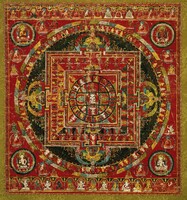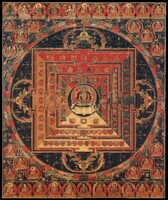 This painting depicts the 7th Dalai Lama Kalzang Gyatso (1708-1757). The composition belongs to a set of likely seven paintings depicting secret Tantric practices. At this time, this composition is the only known example from the full set of paintings (see detail images). There are several other known sets with the same identical composition. The most complete set is in the collection of Tibet House, New Delhi.
This painting depicts the 7th Dalai Lama Kalzang Gyatso (1708-1757). The composition belongs to a set of likely seven paintings depicting secret Tantric practices. At this time, this composition is the only known example from the full set of paintings (see detail images). There are several other known sets with the same identical composition. The most complete set is in the collection of Tibet House, New Delhi.
It is believed that the central figure is Kalzang Gyatso, the 7th Dalai Lama surrounded by siddha figures and Tantric symbolism. The entire set of seven paintings must be understood as a whole to be able to understand individual compositions such as this painting.
According to the Tibet House painting set the known images and compositions are:
1. Avalokiteshvara
2. Kalzang Gyatso
3. Kalzang Gyatso (?)
4. Siddha Figure (Kalzang Gyatso?)
5. Chakrasamvara Meditational Deity
6. Kalachakra Meditational Deity
7. (Unknown subject)
 Surrounding the figure of Kalzang Gyatso there are two sets of eight siddha figures. The outer eight siddhas are named along with the names of eight sacred locations known as a pita (pitha). There are twenty-four & thirty-two sacred pitas in India that are associated with Tantric places of worship. The twenty-four locations are also code names for twenty-four points in the physical body of the Tantric practitioner - the Body Mandala. Two of the other paintings in the complete set have an additional eight siddhas per painting accounting for the remaining sixteen sacred pitas of India (see the Kalachakra and Siddha figure paintings).
Surrounding the figure of Kalzang Gyatso there are two sets of eight siddha figures. The outer eight siddhas are named along with the names of eight sacred locations known as a pita (pitha). There are twenty-four & thirty-two sacred pitas in India that are associated with Tantric places of worship. The twenty-four locations are also code names for twenty-four points in the physical body of the Tantric practitioner - the Body Mandala. Two of the other paintings in the complete set have an additional eight siddhas per painting accounting for the remaining sixteen sacred pitas of India (see the Kalachakra and Siddha figure paintings).
The eight siddhas inhabiting the inner rocky enclosure do not have any name inscriptions and remain unidentified.
In front of the throne seat is a table with various offerings arranged which include the five meats, alcohol and a large white 'torma' - ritual food offering. The five goddesses in dancing postures located at the lower front are the Sense Offering Goddesses representing [1] touch, [2] smell, [3] sight, [4] sound, and [5] taste. (See the numbered image).
There are a number of hidden images placed in the composition. How many can you find?



















